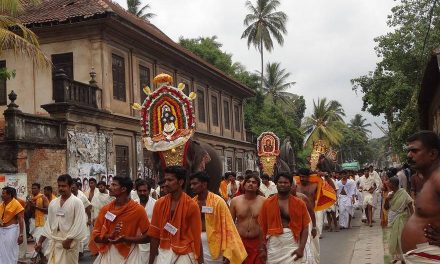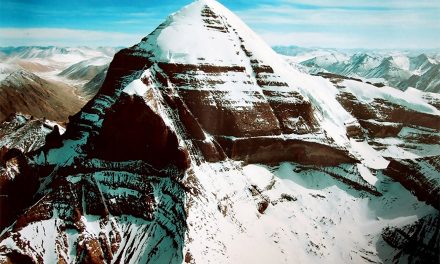The Purusha Sukta (hymn about the Supreme Being) is also a hymn on creation. There have been several editions of this hymn; and it is widely commented and translated in several languages. This hymn is found in all the Vedas with varying number of verses. Thus in the Rigveda this hymn is in 16 verses; Sukla Yajurveda contains 16, Sama Veda seven, and Krishna Yajurveda 18. The edition dealt with here is based on Rangantha Muni’s Sanskrit commentary. He lived in the 13th century and followed the Krishna Yajurveda, which has 18 verses.
In a new book by T. Venkatacharya, the author presents a new approach to the study of this important and difficult hymn. Interpretation of Vedic texts requires a sound traditional background and thorough acquaintance with Vedic grammar. Some of the expressions are archaic and figurative or secondary in import. They should not be understood in the literal sense.
Interpretation
T. Venkatacharya, the expositor and translator of this hymn, combines in himself these qualifications in a full measure. The subtle nuances of Vedic language, the actual import of the hymn and the overall concept of creation have been commendably unfolded by him in this publication. This interpretation, which is quite novel, tries to explain the “mystery” of creation of the universe in as simple a language as possible.
According to the translator, the word `Virat’ refers to the primordial nature (Prakriti) out of which the universe is created. The word Purusha, occurring in the hymn, when it stands alone without any adjective, should be understood in the sense of the four-faced creator Brahma. But if it is qualified by an adjective as in “Mahantam Purusham” and “Sahasrasirsha Purushah”, it refers to the Supreme Being. The act of Srishti (creation) mentioned here is not to be taken literally. It is a “mental act” involving deep meditation. Likewise, the word “yajna” (sacrifice) also is a “mental act”. It should not be taken as involving the sacrifice of any animal, as is generally understood. The Rishi who “saw” this hymn is Narayana. The word “Narayana” denotes the Supreme Being also, but one should distinguish the seer Narayana from God Narayana. Verse 16, which says, “I know this Supreme Person… ” is in support of this view.
These are some of the highlights of the present exposition, which make the approach to the study of this ancient and important Sukta, fresh and “new”. There are many such explanations that make the study of this work a rewarding experience. We congratulate the learned translator for this memorable presentation.
An Introduction to the Purusha Sukta
Where is the Purusha Suktam in the Vedas? An overview from Ramanuja.org:
Hindu religious sources are classified as Sruti or Smrti. Sruti — that which is heard — is of the nature of divine revelation. We believe that the Vedas, hymns composed by seers and sages beginning as best as we can date them in 3000 BC, were sung under divine inspiration. This is why they are Sruti. These sages “heard” them as the voice of the Divine.
Only two bodies of hymns are recognized as divinely composed. One being the Vedas, and the other, the Thiruvaaymozhi of Kaari Maaran Sadagopan, or Sri Nammaazhvaar, which are recognized as equivalent to the 4 Vedas in the Ubhaya Vedanta school, the Sri Vaishnava tradition. The six compositions of Kaliyan Neelan, or Sri Thirumangai Aazhvaar, are recognized as the 6 Vedangas.
[Note: Ubhaya Vedanta refers to the twofold Vedanta, seen through the two eyes of the Sanskrit Upanishads and the Tamil Divya Prabandham. They are of paramount and equal authority to Sri Vaishnavas.]
Smrti is that which is remembered, and includes a large part of the commentary of the Vedas, different Puranas, epics, and other sources.
The Purusha Suktam is one of the Pancha Suktams of the Sri Vaishnava sampradaya or tradition. The other four are the Narayana Suktam, Sri Suktam, Bhu Suktam, and the Nila Suktam.
The Purusha Suktam is seen earliest in the Rg Veda, as the 90th Suktam of its 10th mandalam, with 16 mantrams. Later, it is seen in the Vajasaneyi Samhita of the Shukla Yajur Vedam, the Taittriya Aranyaka of the Krishna Yajur Vedam, the Sama Veda, and the Atharvana Veda, with some modifications and redactions.
In South India, the Purusha Suktam, Vishnu Suktam, Sri Suktam, and Narayana Suktam are generally chanted together in paarayanam. The Sri Rudram, Purusha Suktam, Upanishads, the Gita, and the Vishnu Sahasra Naamam are also recommended for daily paarayanam – chanting.
Since the Purusha Suktam is seen in all Vedas, it is cited as the essence of all Srutis by Srila Veda Vyasa in the Mahabharata. Saunaka, Apastamba, and Bodhayana have also written concerning the use of the Purusha Suktam.
The Rg Veda
What does the Purusha Suktam talk about?
The Purusha in the title of the Purusha Sukta refers to the Parama Purusha, Purushottama, Narayana, in his form as the Virat Purusha. He was the source of all creation. It describes this form of his, as having countless heads, eyes, legs, manifested everywhere, and beyond the scope of any limited method of comprehension. All creation is but a fourth part of him. The rest is unmanifested.
Purusha as Brahma remained inactive, and Aniruddha Narayana, one of the four aspects of Narayana in the first tier at the base of the Vishaaka Yoopa, asked him “Why do you do nothing?” “Because of not knowing,” Brahma replied. “Perform a yajna. Your senses, the devas, shall be the ritviks. Your body shall be the havis. Your heart, the altar. And I shall be he who enjoys the havis — the offering. From your body sacrificed, shall you create bodies for all living creatures, as you have done in kalpas before this.” Thus says the sakalya brahmana.
This yajna was called “sarvahut”, the offering of all. The act of creation itself grew out of yajna, the rite of sacrifice. Who was worshipped at this sacrifice? It was the Purusha. Who performed it? Brahma, the creative aspect of the Purusha. Who were the ritvik priests? The devas, who are the Purusha’s senses. Who was tied as the beast of the sacrifice? Brahma, again. What was barhis, the altar of the sacrifice? All of nature. Who was the fire? The Purusha’s heart. What was sacrificed? Again, the Purusha himself, his great body that contained all of creation.
In a way, this is a message of love, that the Purusha would consume himself in the fire of creation, to create all the worlds. From this sacrifice did all of creation emanate. This is central to the message of the Purusha Sukta.
vedAhametam purusham mahAntam
Aditya varNam tamasaH parastAt
tam evam vidvAn amRta iha bhavati
na anyaH panthA vidyate ‘yanaaya
“The Purusha Sooktam closes, as it began, with that unique and wonderful invocation to peace. In peace all begins, and in peace all ends. All we work for is so peace may flourish.”
[Note: The following is not part of the Purusha Sukta proper. However, it is often chanted at the end and is found in many printed editions.]
tacchamyo-rAvrNeemahe
gAtum yagnyAya
gAtum yagnyapataye
daivee: svastirastu na:
svasti mAnushebhya:
oordhvam jigAtu bheSHajam
sham no astu dvipade
sham chatushpade
om shAnti: shAnti: shAnti:
“Sorrows that are, and sorrows to be We seek that which grants us Peace from these May the rite flourish, And those who keep it. The grace of the gods Be with all mankind. May the earth be covered With growing green And good come to us From all creation From beings that go On two feet and four. May the three-fold peace Embrace the Land.”













My understanding is Hinduism considers projection of the Paratma as everything living and not living rather than creation?Why use the term creation as it goes against the entire basis of Hindu philosophy